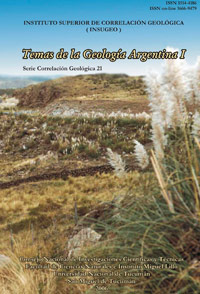Serie Correlación Geológica 21 (1)
Revisión estratigráfica de la Formación Ponón Trehué (Ordovícico), Bloque de San Rafael, Mendoza
Descargar trabajo en formato PDFResumen
REVISIÓN ESTRATIGRÁFICA DE LA FORMACIÓN PONÓN TREHUÉ (ORDOVÍCICO), BLOQUE DE SAN RAFAEL, MENDOZA. Nuevas descripciones y análisis de las rocas ordovícicas aflorantes al sur de Arroyo Ponón Trehué, en el ámbito del Bloque de San Rafael, permiten establecer una reinterpretación estratigráfica de las mismas. La redefinición formal de la Formación Ponón Trehué contempla que estas rocas de edad ordovícica media y superior, mayormente siliciclásticas, conforman una sucesión estratigráfica que permite diferenciar dos miembros: una secuencia basal siliciclástica/carbonática darriwiliana depositada en una plataforma con evidentes signos de exhondación al tope, y otra unidad conformada por depósitos olistostrómicos asignados al Ordovícico Superior que sobreyace a la anterior.
Abstract
STRATIGRAPHIC REVISION OF THE PONÓN TREHUÉ FORMATION (ORDOVICIAN), SAN RAFAEL BLOCK, MENDOZA. This paper provides new descriptions and interpretations of the Ordovician rocks cropping out to the south of the Arroyo de Ponón Trehué, in the San Rafael Block, Mendoza Province. These data allow a new stratigraphic interpretation for the Ordovician rocks which leads to a formal redefinition of the Ponón Trehué Formation. These rocks are mainly siliciclastics (Darriwilian to lower Upper Ordovician), and two members are defined. The lower one is a siliciclastic/carbonate sequence from the upper Middle Ordovician (upper Darriwilian) to the lower Upper Ordovician and the upper one is an olistostrome deposits that is correlated with the lower Upper Ordovician. The stratigraphic succession is interpreted in terms of the following geologic history: 1) Early to early Mid Ordovician: deposition on shallow marine carbonate platform. 2) Mid Ordovician (pre-P. serra zone): exposure and erosion of basement as result of a gentle uplift, which is thought to be a local, but not a regional, event because it is not recorded in other parts of the San Rafael Block nor in the Precordillera. 3) Mid to early Late Ordovician (P. serra to P. anserinus Zones): gentle subsidence and extensive flooding surface, and siliciclastic deposition in gradually deepening marine environment. 4) Early Late Ordovician: rapid increase in rate of deepening (basin subsidence) to create steep basin margin and collapse of carbonate blocks into basin. In order to create accommodation space for the thick olistostrome sequence including large olistoliths and to create steep basin margin necessary to generate gravity slide process, basin subsidence must have been rapid and tectonically driven.






